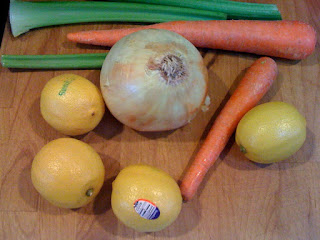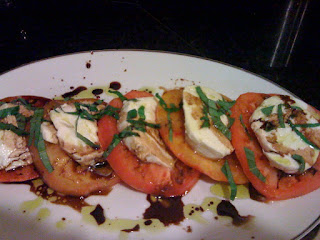I would say that at this point in my cooking adventures, my "cooking" techniques (the actual act of heating the food) are a little limited. I can grill, sautee, and roast. I've also learned a little bit about searing and locking in some of the flavors. All of this is a definite marked improvement; chicken and pork are light years better than before. But, there are a lot of different things that I still want to learn. So, I decided that I was going to tackle poaching, and that I would do it with some fresh Copper River Sockeye Salmon.
 Salmon is without a doubt one of our favorite foods, and I've spent some time learning a couple of different ways to cook it. It's also one of those foods where my experimentation is a little more restricted, especially given that my wife grew up in the Salmon capital of the world, Juneau, AK (it really doesn't get any fresher). Right now the two winners in our household so far are steamed salmon with just a little butter, salt and pepper; or grilled salmon, with a simple brown sugar and soy glaze. So, I knew that when I wanted to try a new cooking technique, I was taking a bit of a risk. Fortunately, I had the recipe stylings of Michael Symon on my side, so I jumped in.
Salmon is without a doubt one of our favorite foods, and I've spent some time learning a couple of different ways to cook it. It's also one of those foods where my experimentation is a little more restricted, especially given that my wife grew up in the Salmon capital of the world, Juneau, AK (it really doesn't get any fresher). Right now the two winners in our household so far are steamed salmon with just a little butter, salt and pepper; or grilled salmon, with a simple brown sugar and soy glaze. So, I knew that when I wanted to try a new cooking technique, I was taking a bit of a risk. Fortunately, I had the recipe stylings of Michael Symon on my side, so I jumped in. In his cookbook, he shows three different poaching methods, two of which called specifically for salmon. The first was a court bullion poaching liquid, while the other was a butter poaching method. I was really interested in butter poaching and fusing the butter flavor into the fish. But, I don't currently have a good thermometer and with butter it is incredibly important to keep it at the right temperature to prevent it from breaking down. So, I decided I would wait until I got the tools I need, and instead opted for the bullion method.

 After that, it was pretty easy. I simply heated the liquid until it was steaming, almost simmering, but not quite. If I had a good thermometer, I would have just brought it up to about 175. Then I added the salmon, which I had added a little salt and pepper to, and basically let it soak for about ten minutes. About half way through, I wanted to flip the salmon over just to make sure that it was covered completely. As I went to flip it with the tongs, it simply flaked apart, it was so tender. Once it was done, I pulled it out, and served it with a variation of my risotto (bacon, roasted red and yellow peppers, no purees) as well as a caprese salad* (see note at end).
After that, it was pretty easy. I simply heated the liquid until it was steaming, almost simmering, but not quite. If I had a good thermometer, I would have just brought it up to about 175. Then I added the salmon, which I had added a little salt and pepper to, and basically let it soak for about ten minutes. About half way through, I wanted to flip the salmon over just to make sure that it was covered completely. As I went to flip it with the tongs, it simply flaked apart, it was so tender. Once it was done, I pulled it out, and served it with a variation of my risotto (bacon, roasted red and yellow peppers, no purees) as well as a caprese salad* (see note at end).*Cook's Note on Caprese - The Caprese that we had with the salmon turned out deliciously. I couldn't have been more pleased. But, a successful caprese has very little to do with the cook's technique (at least in my opinion). The biggest indicator of success is the quality of the ingredients. I simply purchased fresh, organic heirloom tomatoes, a very flavorful olive oil, a nice balsamic vinegar, and fresh mozzarella. I then added fresh basil from our garden, and some ground sea salt and black pepper. These ingredients are a magical combination together, and this dish truly shows why purchasing quality ingredients can make or break the meal before you even begin.









No comments:
Post a Comment